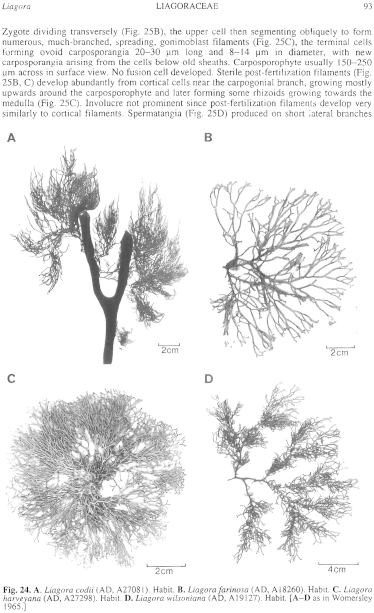|
|
|
|
|
|||||||||||
|
Electronic Flora of South Australia Species Fact Sheet
Phylum Rhodophyta – Class Florideophyceae – Order Nemaliales – Family Liagoraceae
Selected citations: Levring 1953: 500, figs 31, 32A–D. Lucas & Perrin 1947: 134. Womersley 1965: 483, figs 70–75, pl. 7 fig. 2.
Synonyms
L. pulverulenta C. Agardh sensu Sonder 1846: 153. Kützing 1858: 42, pl. 89a, b. Harvey 1863, synop.: xxxviii.
L. distenta (Roth) Lamouroux sensu Harvey 1855a: 552; 1863, synop.: xxxviii. Sonder 1846: 153.
L. albicans Lamouroux sensu Kützing 1858: 43, pl. 89c-e.
Thallus (gametophyte) (Fig. 24D) brownish red with a grey calcareous cover but often mucilaginous, moderately to heavily calcified, 5–15 cm high, with one to numerous terete axes; axes subdichotomously branched at fairly long intervals (2–5 cm), more closely dichotomous near the apices, clothed with short lateral branches throughout their length but which are often lost near the base of the thallus; laterals 0.5–1.5 (–3) cm long, simple to subdichotomously branched a few times; axes 1–2 mm in diameter below, laterals 0.3–0.6 (–1) mm in diameter. Holdfast discoid, 1–5 mm across; epilithic. Structure of a medulla of filaments of long cells, mostly 10–12 µm in diameter near apices, becoming 40–50 µm in diameter in older parts, interspersed with slenderer rhizoids, and a cortex (Fig. 26H) 150–250 µm broad, often lost from oldest parts of thallus, consisting of subdichotomously branched filaments [7–11 (–14) µm in diameter] of ovoid cells commonly highly vacuolate, branched every 1–2 cells in young laterals, often less branched on older parts of thallus; filaments on young branches strongly moniliform (Fig. 26H), less so on older parts of thallus; central cells L/D 1.5–2.5 (–3), shorter near apices of filaments and longer near the base; basal cells of filaments producing rhizoids; rhodoplasts (Fig. 26M) stellate to reticulate, with a central pyrenoid; hairs present on terminal cortical cells near branch apices.
Tetrasporophyte unknown.
Reproduction: Sexual thalli dioecious. Carpogonial branches (Fig. 26H, I) curved, lateral on basal to mid cells of cortical filaments, 3- or 4-celled with a conical carpogonium. Zygote dividing more or less transversely once (Fig. 26J) or rarely twice, the upper cell developing erect branched gonimoblast filaments (Fig. 26K) forming a dense, hemispherical carposporophyte (100–150 µm across in surface view) with terminal ovoid carposporangia 12–20 µm in length and 6–10 µm in diameter. Pit-connections of the carpogonial branch broadening as the carposporophyte develops, ultimately forming a distinct fusion cell (Fig. 26L) involving also the lower gonimoblast cells and sometimes the supporting cell. Sterile filaments (Fig. 26J, K) develop immediately after fertilization from cortical cells adjacent to the supporting cell, forming a prominent loose mass around the old carpogonial branch; these sterile filaments develop a prominent involucre of slender, curved filaments of elongate cells around the carposporophyte, remaining distinct from the cortical filaments (Fig. 26L); involucral filaments usually branched both near their bases and apices. Spermatangia (Fig. 26M) produced abundantly in capitate clusters at apices of cortical filaments; terminal cortical cells cutting off from their upper ends several elongate spermatangial initials, each forming several spermatangia; spermatangia ovoid, 2–3 µm in diameter.
Type from Western Port, Vic. (J.B. Wilson, 1896); in BM.
Selected specimens: "Nov. Holt. occid." (Preiss, MEL 8588, as L. albicans?). Catherine Bay, Rottnest I., W. Aust., 15 m deep (Huisman, 20.xii.1992; Murdoch, J.H. 274). Chinaman Hat I. bay, Yorke Pen., S. Aust., upper sublittoral (Woelkerling, 17.i.1968; AD, A32129). Marino, S. Aust., upper sublittoral (Brock, 24.ii.1984; AD, A55089). Pennington Bay, Kangaroo I., S. Aust., low eulittoral (Womersley, 6.i.1949; AD, A10784). Robe, S. Aust., in shallow pools (Womersley, 20.xii.1953; AD, A19127). Newfield Bay (2 km E of Peterborough), Vic., lower eulittoral pools (Womersley, 10.xii.1969; AD, A34807 -"Marine Algae of southern Australia" No. 75). Walkerville, Vic., at low tide level (Sinkora A1784, 21.xi.1973; AD, A53486).
Distribution: Western Australia (probably near Perth, possibly as far north as Dongara) around southern Australia to Walkerville, Vic; not known from Tasmania.
References:
HARVEY, W.H. (1855a). Some account of the marine botany of the colony of Western Australia. Trans. R. Ir. Acad. 22, 525–566.
HARVEY, W.H. (1863). Phycologia Australica. Vol. 5, Plates 241–300, synop., pp. i-lxxiii. (Reeve: London.)
KÜTZING, F.T. (1858). Tabulae Phycologicae. Vol. 8. (Nordhausen.)
LEVRING, T. (1953). The marine algae of Australia. I. Rhodophyta: Goniotrichales, Bangiales and Némalionales. Arkiv för Bot. Ser. 2, 2, 457–530.
LUCAS, A.H.S. & PERRIN, F. (1947). The Seaweeds of South Australia. Part 2. The Red Seaweeds. (Govt Printer: Adelaide.)
SONDER, O.W. (1846). Algae. In Lehmann, C., Plantae Preissianae. Vol. 2, pp. 148–160. (Hamburg.)
WOMERSLEY, H.B.S. (1965). The Helminthocladiaceae (Rhodophyta) of southern Australia. Aust. J. Bot. 13, 451–487, Plates 1–7.
ZEH, W. (1912). Neue Arten der Gattung Liagora. Berlin Univ. Bot. Gart. Notizbl. 5, 268–273.
The Marine Benthic Flora of Southern Australia Part IIIA complete list of references.
Publication:
Womersley, H.B.S. (14 January, 1994)
The Marine Benthic Flora of Southern Australia
Rhodophyta. Part IIIA, Bangiophyceae and Florideophyceae (to Gigartinales)
Reproduced with permission from The Marine Benthic Flora of Southern Australia Part IIIA 1994, by H.B.S. Womersley. Australian Biological Resources Study, Canberra. Copyright Commonwealth of Australia.
Illustrations in Womersley Part IIIA, 1994: FIGS 24D, 26 H–M.

Figure 24 enlarge
Fig. 24. A. Liagora codii (AD, A27081). Habit. B. Liagora farinosa (AD, A18260). Habit. C. Liagora harveyana (AD, A27298). Habit. D. Liagora wilsoniana (AD, A19127). Habit. [A–D as in Womersley 1965.]

Figure 26 enlarge
Fig. 26. A–F. Liagora harveyana (AD, A4443). A. Cortical filaments with a carpogonial branch. B. Carpogonial branch. C. First zygote division and young sterile filaments. D. Older gonimoblast and sterile filaments. E. Mature carposporophyte with some divided carposporangia. F. Cortical filaments with spermatangia. G. Tetrasporophyte with tetrasporangia. H–M. Liagora wilsoniana (AD, A10784). H. Cortical filaments with a carpogonial branch. I. Carpogonial branch. J. First zygote division and young sterile filaments. K. Young gonimoblast and sterile filaments. L. Almost mature carposporophyte and involucre of sterile filaments. M. Spermatangial branches. [A–E, H–M after Womersley 1965; G after Guiry 1990, fig.11.]

|
Email Contact: State Herbarium of South Australia |

|